This week, students, educators and advocates are celebrating Computer Science Education Week, an annual event, held in recognition of the birthday of computing pioneer Admiral Grace Murray Hopper, dedicated to inspiring K-12 students to take an interest in computer science.
Millions will participate, whether by taking part in an Hour of Code or attending school- or community-based activity.
As you may have noticed, 2016 has been a major year of action in support of computer science.
In January, the White House announced the Computer Science for All initiative, which aims to bring computer science education to every student in the nation.
With a commitment of $120 million over five years from the National Science Foundation, $17M from the Corporation for National and Community Service, the support of companies like Microsoft, Google and Facebook and organizations like Teach for American and Code.org, and a call for $4 billion in funding for all 50 states to train teachers, expand access to high-quality instructional materials, and build effective regional partnerships, it represents a significant milestone in the push for nationwide computer science education.
And momentum is building. Since January, 14 new states have expanded CS education, more than 500 organizations have responded to the President’s call to action, and a new AP Computer Science course, launched this fall, is already being offered in more than 2,000 classrooms.
Yet, despite the growing number of jobs that involve some kind of computing skill or understanding, and the excitement around computer science from students and parents, CS is still taught in a minority of high schools and few middle school or elementary schools offer any computer science experiences.
In 18 states, these classes don't even count towards math or science graduation requirements, limiting participation further. Among the schools that do teach CS, students of color, girls, and students in high-need schools are less likely to take computer science than other students.
But the landscape is rapidly changing. Across the U.S., school districts, cities, and even entire states are rallying behind computer science and recognizing its importance as a basic literacy for students of all ages.
Above and beyond these commitments, it will take a concerted, all-hands-on-deck effort to make sure students of all genders, races, ethnicities and abilities are able to study computer science.
What do we mean by Computer Science for All?
CS education — in the ambitious form that its advocates are pursuing — doesn't just mean computer literacy or the ability to design a website or program an app. Rather, it means giving students computational problem-solving skills while also instilling in them a comprehensive idea of how computing and computational thinking influence their ability to be engaged citizens in the 21st century.
And not just for some students.
"Computer science is for everyone," said Jan Cuny, a Program Officer at the National Science Foundation (NSF). "Of course it’s necessary for students aiming for IT careers, but it will also create opportunities for students with interests in biology, chemistry, physics, astronomy, engineering, medicine, education, marketing, communications, journalism, art and music!

In the December 2015 issue of the ACM Inroads magazine dedicated to Computer Science Education, Quincy Brown, a Senior Policy Advisor at the White House Office of Science and Technology Policy, wrote: "We're at an exciting moment in history with unprecedented collaboration between many groups — K-12 and postsecondary educational institutions, government, industry, professional and non-profit organizations — all working together towards a common vision of expanded access and opportunity in computer science."
As Brown notes, it will take a broad coalition to get something as big as a new area of study off the ground and into classrooms. After all, it took many decades (or centuries) for the pedagogy and infrastructure required to effectively teach math or chemistry to establish itself.
Below are some of the key stakeholders who are helping to bring CS education to every student in the nation.
Teachers
On the front lines of the CS education movement are teachers — some with computer science degrees, others with math, science, business, history or art backgrounds — who see the need and value of computer science, advocate within their schools for new CS courses and volunteer to teach the new classes.
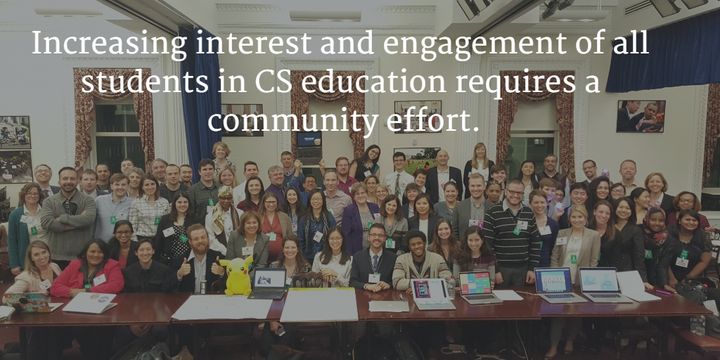
Educators, students, and developers generate new ideas for bringing computer science education to elementary school classrooms at first-ever White House Computer Science Tech Jam, December 7, 2015.
These teachers are the trailblazers of computational thinking — a way of solving problems by breaking them down into sub-problems and considering all possible solutions, much like a computer would do.
For the past three years, NSF, National Center for Women and Information Technology (NCWIT) and the College Board have organized meetings of superstar computer science teachers from across the U.S. — teachers who are innovating in their schools, recruiting students who otherwise might not sign up for CS classes, and organizing to get computer science taught throughout their states.
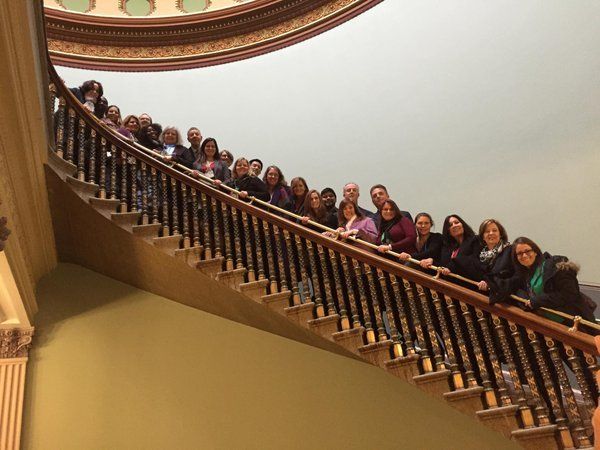
Teachers gather at the White House during the 100 CS Teachers Meeting in December 2014.
"I don't expect all my students to be programmers, but it is exciting to seeing how students with different career interest discover how Computer Science has a role in their career choice," said Gina McCarley, a CS teacher at Lawrence County High School in Moulton, Alabama. "Can you imagine what innovations are to come when you have future health care workers, agriculture professionals, construction workers, engineers and students with other career interests learning Computer Science Principles?"
[Hear some real talk from Computer Science teachers, like Plotnick, as they discussed the highs, lows and continuing efforts to bring computer science education to every student in the country.]
Administrators
Regardless of how passionate they are, teachers can't unilaterally decide to bring computer science to their schools. Introducing a new course requires the support and agreement of forward-thinking administrators: principals, superintendents, members of boards of education and even in some cases mayors and governors.
In 2014, Chicago pledged to make a yearlong computer science course a high school graduation requirement by 2018 and to offer computer science to at least a quarter of elementary school children by then. And New York City Mayor Bill De Blasio made headlines in 2015 with plans to bring computer science to all students in the city within 10 years.
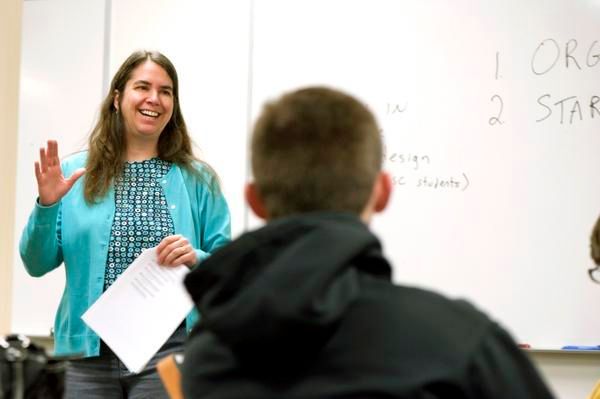
Marie desJardins, a professor of Computer Science at the University of Maryland, Baltimore County, leads an NSF's funded project to building community and knowledge to increase statewide support for computing education in Maryland.
The effort is gaining speed. This year, 70 districts and more than 280 schools across 39 state signed the CSforAll K-12 Pledge to support and promote implementation of CSforAll in their communities.
But the question remain: will there be enough well-trained computer science teachers available to meet these commitments?
Non-profits
In the midst of such a pressing need for more computer science teachers, a host of not-for-profit organizations have taken up the CS education banner and have become a powerful force advocating for, and often leading, efforts to bring CS courses to schools and districts.
Teach for America (TFA) is one such organization. With support from NSF, TFA conducted a pilot program at five New York City public high schools in 2013-2014 to develop a new model for recruiting and training teachers to effectively teach Exploring Computer Science - an introductory course intended for all students, with a focus on equity, developed and implemented with funding by NSF.
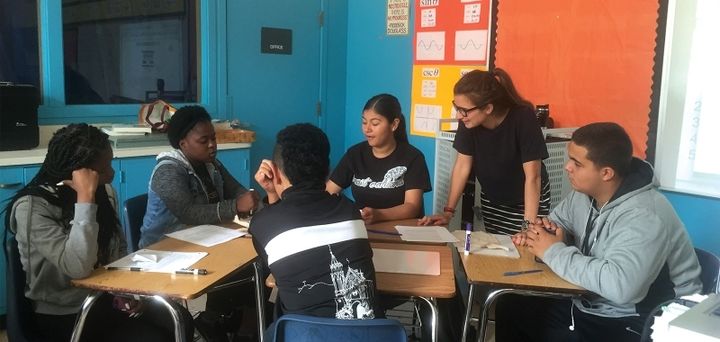
Teach for America is piloting an effort to develop a new model for recruiting and training teachers to effectively teach Exploring Computer Science.
In 2015, NSF awarded TFA a further grant to bring an updated model of high school computer science education to New York, South Carolina, Kansas City, the Rio Grande Valley, and up to six more regions. The new program supports participants in building the school relationships necessary to get computer science into classrooms, setting the stage for more CS instructional time in upcoming years.
“Though the number of schools offering computer science courses is increasing, and more students are taking advanced computer science exams, this hasn’t resulted in increased access for low-income students, students of color and female students,” said Paula Garcia, executive director of Teach For America in the Rio Grande Valley. “Our teachers are deeply committed to connecting local students with the technology resources and tools that will be essential in 21st-century careers.”
Social entrepreneurs
Teaching computer science in classrooms is critical, but it's not the only way students can be exposed to CS. After-school programs and summer camps are two other routes to student engagement, and in this area, grassroots efforts led by groups like the Level Playing Field Institute, CompuGirls and Black Girls Code are having a major impact.
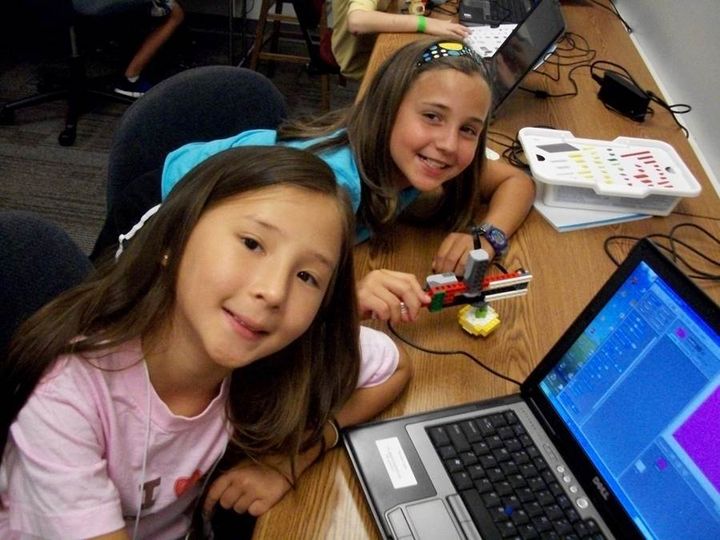
Girls from the Georgia Computes! summer camp learn computer science.
The Level Playing Field Institute Summer Math and Science Honors Academy (SMASH) is a free, STEM-intensive, college preparatory program for high school students of color. SMASH offers a rigorous 5-week, 3-year summer STEM enrichment program and provides access to mentors, role models and support networks of students of color. To date, SMASH has helped hundreds of students across California take and pass the current AP Computer Science (CS A) exam.
Black Girls CODE, launched 2011, introduces computer coding to young girls from underrepresented communities through community workshops and after-school programs. By teaching girls programming and game design, they start a lifelong process of developing a love for technology and the self-confidence that comes from understanding the greatest tools of the 21st century.
CompuGirls at the Arizona State University, represents another example of the growing effort to focus on engaging girls of color in computing. Led by Kim Scott, a Presidential Change Agent, CompuGirls is opening the first university center focused on educating girls of color in STEM fields.
“Although we may sound like a computer science endeavor, our main focus is self-development,” Scott wrote in a 2014 article in Slate. “We help girls envision their futures beyond what other social institutions — such as school— may imagine for them. We trust them to shift their identities from those negative images to more empowered shades of their selves.”
Collectively, these social entrepreneurs are having a major impact on broadening participation in computer science, working inside and outside the formal education system.
Industry
The technology sector is one of the fastest growing segments of the labor market and — though hotly debated — many believe there are not enough students gaining the skills needed to fill all the anticipated jobs.
Even more evident is the need for far greater diversity among tech workers, both for equity's sake, and because the lack of engagement limits the pool of trained technologists.
For this reason (and because it's the right thing to do), industry has been a major champion of CS education, dedicating funds to proven programs, donating technology to schools, and partnering with districts to train teachers to bring CS education to all students.
In 2015, Microsoft announced it will invest $75 million over the next three years in initiatives to increase access to computer science education for youth.

Microsoft CEO Satya Nadella meets with students at the Laboratory School of Finance and Technology, Wednesday, Dec. 10, 2014, in the Bronx borough of New York.
"We don't have enough people in the country with the skills to fill the jobs that our industry is going to create," Microsoft President Brad Smith said at the time of the announcement. "Even more than that, we are not creating opportunities for everyone across the country. We see that most notably in the shortage of African Americans, Latinos, girls and women entering the tech sector."
Google, Salesforce, and even the Cartoon Network have made large commitments as well. Together these investments are helping to speed up the training of teachers, the development of new programs and the adoption of CS education classes.
Academic Researchers
Much of the vision for high-quality, equitable and rigorous computer science education comes from university researchers who are experts in how to teach students skills, engage diverse learners, and develop comprehensive curricula — who in fact have studied these questions and developed proven solutions.
Jane Margolis is one such researcher. A professor at UCLA, Margolis has dedicated her career to democratizing computer science education and addressing underrepresentation in the field. With support from NSF, Margolis and her team developed "Exploring Computer Science," or ECS — a course for high school and college-level students that helps get girls and underrepresented minorities interested in computer science.
ECS encourages students to explore computer science through hands-on learning projects and collaborative problem-solving, which Margolis believes are at the heart of computer science. Today, more than 2,000 students in the Los Angeles United School District — most of them African American and Latino — are learning computer science through ECS each year. Additionally, ECS is being picked up by schools all across the U.S.
Another project, LeadCS.org — led by Jeanne Century at the University of Chicago's Center for Elementary Mathematics and Science Education — developed the tools and resources that K-12 districts and school leaders, teachers, and their advocates need, in order to bring computer science education in their schools.
"Computer science education is in an exciting renaissance that we can leverage to redefine who reaps the benefits of computer science education in college, career and life," Century says. "If we take advantage of this unprecedented opportunity to bring coherence to our varied efforts, align our interests, and agree on what quality looks like, we can put this revitalization on a trajectory toward permanently increasing opportunities for all kids."
LeadCS.org released a toolkit in 2015 that is helping districts around the country organize to get CS education taught in their schools.
In some cases, academic entities are offering skills-based learning and professional experiences in areas that are even more specialized than just computational thinking and computer science. One example is the Texas Advanced Computing Center (TACC) — a research center that deploys some of the world's most powerful supercomputers and helps researchers solve complex problems with real-world significance.
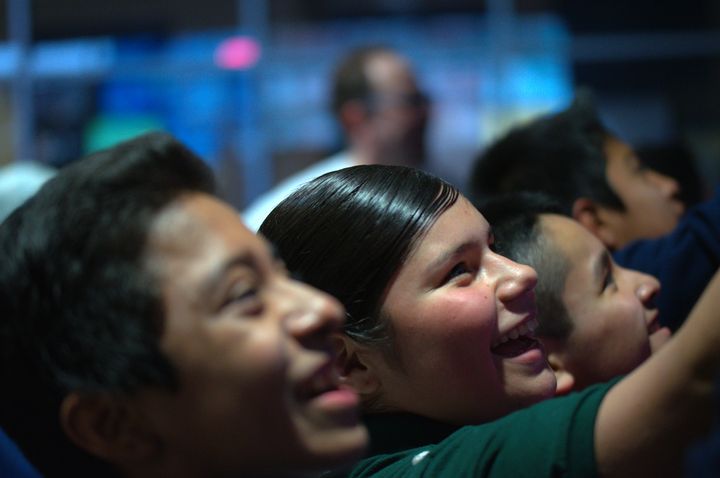
Middle school students interact with advanced technology in the TACC Visualization Laboratory.
Over the past several years, TACC piloted STEM education and outreach programs that teach parallel programming and advanced computing — topics of growing interest to industry — to diverse high school and undergraduate students.
Efforts such as CODE@TACC, the Integrative Computational Education and Research Traineeship (ICERT) and the Verizon Innovative Learning Summer Entrepreneurship Program are training dozens of students from underrepresented groups each year and heeding the National Academies’ 2016 report call to create and sustain “a computationally skilled workforce that reflects our nation.”
Parents
Parents, too, play a critical role in the adoption of CS education by encouraging their children to take a CS class and advocating at the school or district level.
In 2015, Google and Gallup released a report, "Images of Computer Science: Perceptions among Students, Parents and Educators in the U.S.," that found that parents see the value of computer science education, even more so than even teachers or administrators.
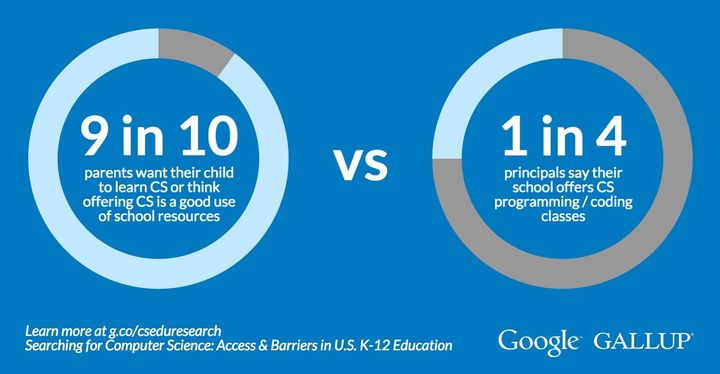
Infographic from Google/Gallup's "Searching for Computer Science: Access and Barriers in U.S. K-12 Education" report.
67% of parents of children in grades 7 through 12 say that most students should be required to learn computer science and more than 8 in 10 parents say that computer science is at least as important as core subjects such as math and English. Interestingly, parents in low-income households were the most likely to value CS.
Mentors
Mentoring has significant positive effects on student outcomes and can have a profound effect on engaging underrepresented individuals. Given the significant underrepresentation of certain populations within computer science, mentoring individuals from these communities is critical to diversifying the field.
Two efforts that have shown success in this regard are the Computing Alliance of Hispanic-Serving Institutions (CAHSI) and the Institute for African-American Mentoring in Computing Sciences (iAAMCS).
CAHSI, which was identified by the White House as one of the nation's "Bright Spots in Hispanic Education," works to increase the number of Hispanic students who pursue and complete baccalaureate and advanced degrees in computer and information sciences and engineering. In 2014, CAHSI was responsible for approximately 10 percent of all Hispanic students in the U.S. graduating with undergraduate degrees in computer science.
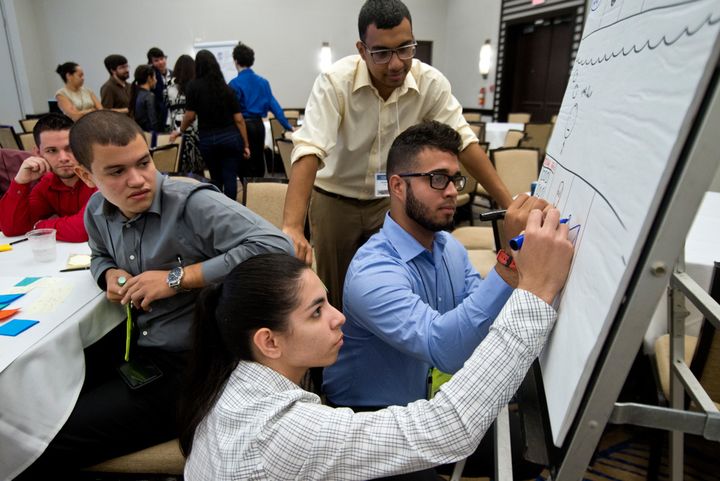
Computing Alliance of Hispanic-Serving Institutions (CAHSI), which works to increase the number of Hispanic students who pursue and complete baccalaureate and advanced degrees in computer and information sciences and engineering, was identified by the White House as one of the nation's "Bright Spots in Hispanic Education."
African Americans make up 13.1% of the U.S. population but only 1.8% of the PhDs awarded in Computer Science. Led by Juan Gilbert, a computer and information science professor at the University of Florida, iAAMCS uses mentoring, advising, and greater access to research opportunities to bring more African-Americans into the advanced technology workforce.
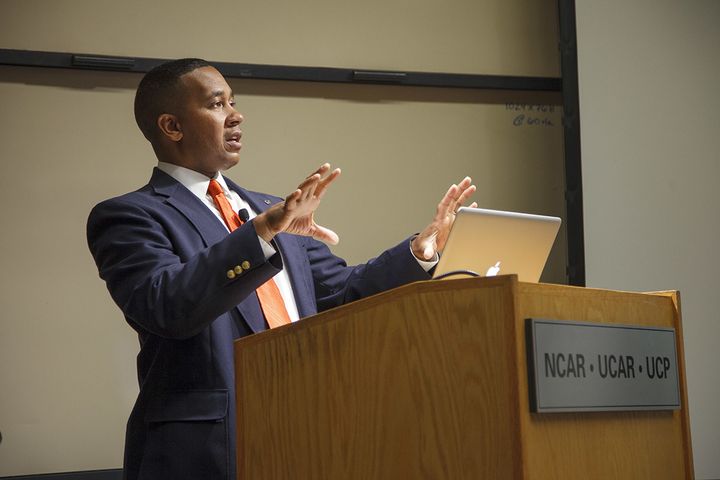
Juan Gilbert, a computer and information science professor at the University of Florida leads the Institute for African-American Mentoring in Computing Sciences (iAAMCS), which seeks to increase the number of African-Americans receiving Ph.D. degrees in computing sciences.
Government
Federal support for teacher professional development, the AP Computer Science Principles framework, and innovative summer, afterschool, and mentoring programs have helped to develop an ecosystem that's cultivating increased access to CS education. Working with partners — non-profits, industry, community leaders, and other federal agencies — has also been critical in this expansion of CS Ed.
Fifteen Federal agencies are currently coordinating efforts to expand CS education, with new investments increasing every year, and 27 governors have called on Congress to support CS education.
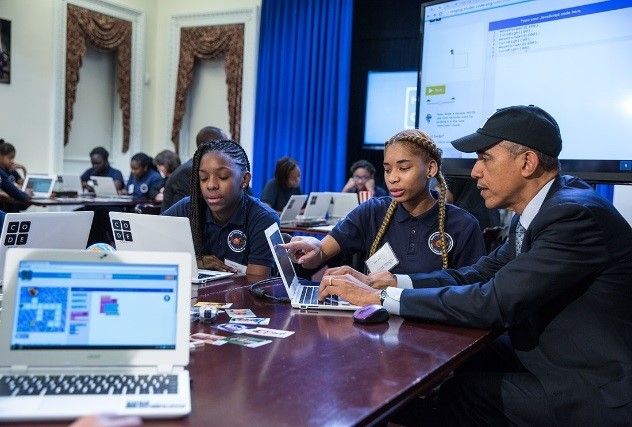
On December 8, 2014, President Obama met with students participating in an "Hour of Code" event at the White House.
A significant sign of the growing acceptance of CS education came in October 2015 when Congress passed the STEM Education Act of 2015 that specifically defined STEM so that it includes computer science at a number of federal agencies.
Of course, these are only a small sample of the full community effort required to bring computer science education to all.
[Jan Cuny, Kamau Bobb, and Gera Jochum from the National Science Foundation, and Quincy Brown from the White House OSTP, contributed to the reporting for this article.]